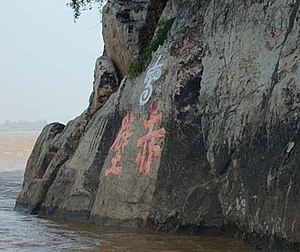
Back معركة المنحدرات الحمراء Arabic Çibi döyüşü Azerbaijani قیزیل کایالار دؤیوشو AZB ཁྲི་པི་གཡུལ་འགྱེད། Tibetan Batalla dels Penya-segats Rojos Catalan Schlacht von Chibi German Batalla de los Acantilados Rojos Spanish نبرد صخرههای سرخ Persian Punaisen kallion taistelu Finnish Bataille de la Falaise rouge French
| Battle of Red Cliffs | |||||||||
|---|---|---|---|---|---|---|---|---|---|
| Part of the wars at the end of the Han dynasty | |||||||||
 Engravings on a cliff-side near a widely accepted candidate site for the battlefield, in the vicinity of Chibi, Hubei. The engravings are at least 1000 years old, and include the Chinese characters 赤壁 ('red cliffs') written from right to left. | |||||||||
| |||||||||
| Belligerents | |||||||||
| Cao Cao | |||||||||
| Commanders and leaders | |||||||||
| Cao Cao | |||||||||
| Strength | |||||||||
| 50,000[3] | |||||||||
| Casualties and losses | |||||||||
| Unknown | Heavy | ||||||||
| Battle of Red Cliffs | |||||||||||||||||||||
|---|---|---|---|---|---|---|---|---|---|---|---|---|---|---|---|---|---|---|---|---|---|
| Traditional Chinese | 赤壁之戰 | ||||||||||||||||||||
| Simplified Chinese | 赤壁之战 | ||||||||||||||||||||
| |||||||||||||||||||||
The Battle of Red Cliffs, also known as the Battle of Chibi, was a decisive naval battle in China that took place during the winter of AD 208–209.[4] It was fought on the Yangtze River between the forces of warlords controlling different parts of the country during the end of the Han dynasty. The allied forces of Sun Quan, Liu Bei, and Liu Qi based south of the Yangtze defeated the numerically superior forces of the northern warlord Cao Cao. By doing so, Liu Bei and Sun Quan prevented Cao Cao from conquering any lands south of the Yangtze, frustrating Cao Cao's efforts to reunify the territories formerly held by the Eastern Han dynasty.
The allied victory at Red Cliffs ensured the survival of Liu Bei and Sun Quan and left them in control of the Yangtze, establishing defensible frontiers that would later serve as the basis for the states of Shu Han and Eastern Wu during the Three Kingdoms period (220–280).[5] Historians have arrived at different conclusions in their attempts to reconstruct the timeline of events at Red Cliffs. The location of the battlefield itself remains a subject of debate:[6] most scholars consider either a location southwest of present-day Wuhan, or a location northeast of Baqiu in present-day Yueyang, Hunan as plausible candidate sites for the battle. The battle has been the subject of or influenced numerous poems, dramas, movies and games.
- ^ de Crespigny (2007), p. 538.
- ^ Farmer (2019), p. 69.
- ^ a b c de Crespigny (2010), pp. 183–184.
- ^ de Crespigny (1990), p. 264, "The engagement at the Red Cliffs took place in the winter of the 13th year of Jian'an, probably about the end of 208."
- ^ de Crespigny (1990), p. 273.
- ^ de Crespigny (1990), p. 256 (§n78).
Cite error: There are <ref group=lower-alpha> tags or {{efn}} templates on this page, but the references will not show without a {{reflist|group=lower-alpha}} template or {{notelist}} template (see the help page).